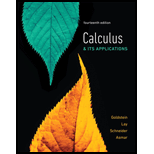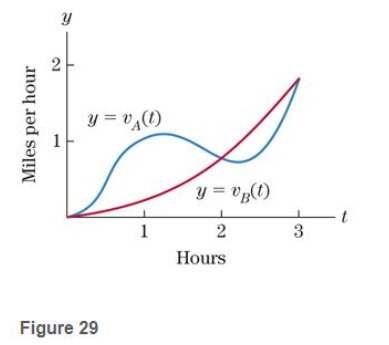
Concept explainers
Distance TraveledCars A and B start at the same place and travel in the same direction, with velocities after
What does the area between two curves from
At what time will the distance between the cars be greatest?

Want to see the full answer?
Check out a sample textbook solution
Chapter 6 Solutions
Student Solutions Manual for Calculus & Its Applications and Calculus & Its Applications, Brief Version
- 6. (i) Sketch the trace of the following curve on R², (t) = (sin(t), 3 sin(t)), tЄ [0, π]. [3 Marks] Total marks 10 (ii) Find the length of this curve. [7 Marks]arrow_forwardhelppparrow_forward7. Let F(x1, x2) (F₁(x1, x2), F2(x1, x2)), where = X2 F1(x1, x2) X1 F2(x1, x2) x+x (i) Using the definition, calculate the integral LF.dy, where (t) = (cos(t), sin(t)) and t = [0,2]. [5 Marks] (ii) Explain why Green's Theorem cannot be used to find the integral in part (i). [5 Marks]arrow_forward
- 6. Sketch the trace of the following curve on R², п 3п (t) = (t2 sin(t), t2 cos(t)), tЄ 22 [3 Marks] Find the length of this curve. [7 Marks]arrow_forwardTotal marks 10 Total marks on naner: 80 7. Let DCR2 be a bounded domain with the boundary OD which can be represented as a smooth closed curve : [a, b] R2, oriented in the anticlock- wise direction. Use Green's Theorem to justify that the area of the domain D can be computed by the formula 1 Area(D) = ½ (−y, x) · dy. [5 Marks] (ii) Use the area formula in (i) to find the area of the domain D enclosed by the ellipse y(t) = (10 cos(t), 5 sin(t)), t = [0,2π]. [5 Marks]arrow_forwardTotal marks 15 Total marks on paper: 80 6. Let DCR2 be a bounded domain with the boundary ǝD which can be represented as a smooth closed curve : [a, b] → R², oriented in the anticlockwise direction. (i) Use Green's Theorem to justify that the area of the domain D can be computed by the formula 1 Area(D) = . [5 Marks] (ii) Use the area formula in (i) to find the area of the domain D enclosed by the ellipse (t) = (5 cos(t), 10 sin(t)), t = [0,2π]. [5 Marks] (iii) Explain in your own words why Green's Theorem can not be applied to the vector field У x F(x,y) = ( - x² + y²²x² + y² ). [5 Marks]arrow_forward
- Total marks 15 པ་ (i) Sketch the trace of the following curve on R2, (t) = (t2 cos(t), t² sin(t)), t = [0,2π]. [3 Marks] (ii) Find the length of this curve. (iii) [7 Marks] Give a parametric representation of a curve : [0, that has initial point (1,0), final point (0, 1) and the length √2. → R² [5 Marks] Turn over. MA-201: Page 4 of 5arrow_forwardTotal marks 15 5. (i) Let f R2 R be defined by f(x1, x2) = x² - 4x1x2 + 2x3. Find all local minima of f on R². (ii) [10 Marks] Give an example of a function f: R2 R which is not bounded above and has exactly one critical point, which is a minimum. Justify briefly your answer. [5 Marks] 6. (i) Sketch the trace of the following curve on R2, y(t) = (sin(t), 3 sin(t)), t = [0,π]. [3 Marks]arrow_forwardA ladder 25 feet long is leaning against the wall of a building. Initially, the foot of the ladder is 7 feet from the wall. The foot of the ladder begins to slide at a rate of 2 ft/sec, causing the top of the ladder to slide down the wall. The location of the foot of the ladder, its x coordinate, at time t seconds is given by x(t)=7+2t. wall y(1) 25 ft. ladder x(1) ground (a) Find the formula for the location of the top of the ladder, the y coordinate, as a function of time t. The formula for y(t)= √ 25² - (7+2t)² (b) The domain of t values for y(t) ranges from 0 (c) Calculate the average velocity of the top of the ladder on each of these time intervals (correct to three decimal places): . (Put your cursor in the box, click and a palette will come up to help you enter your symbolic answer.) time interval ave velocity [0,2] -0.766 [6,8] -3.225 time interval ave velocity -1.224 -9.798 [2,4] [8,9] (d) Find a time interval [a,9] so that the average velocity of the top of the ladder on this…arrow_forward
- Total marks 15 3. (i) Let FRN Rm be a mapping and x = RN is a given point. Which of the following statements are true? Construct counterex- amples for any that are false. (a) If F is continuous at x then F is differentiable at x. (b) If F is differentiable at x then F is continuous at x. If F is differentiable at x then F has all 1st order partial (c) derivatives at x. (d) If all 1st order partial derivatives of F exist and are con- tinuous on RN then F is differentiable at x. [5 Marks] (ii) Let mappings F= (F1, F2) R³ → R² and G=(G1, G2) R² → R² : be defined by F₁ (x1, x2, x3) = x1 + x², G1(1, 2) = 31, F2(x1, x2, x3) = x² + x3, G2(1, 2)=sin(1+ y2). By using the chain rule, calculate the Jacobian matrix of the mapping GoF R3 R², i.e., JGoF(x1, x2, x3). What is JGOF(0, 0, 0)? (iii) [7 Marks] Give reasons why the mapping Go F is differentiable at (0, 0, 0) R³ and determine the derivative matrix D(GF)(0, 0, 0). [3 Marks]arrow_forward5. (i) Let f R2 R be defined by f(x1, x2) = x² - 4x1x2 + 2x3. Find all local minima of f on R². (ii) [10 Marks] Give an example of a function f: R2 R which is not bounded above and has exactly one critical point, which is a minimum. Justify briefly Total marks 15 your answer. [5 Marks]arrow_forwardTotal marks 15 4. : Let f R2 R be defined by f(x1, x2) = 2x²- 8x1x2+4x+2. Find all local minima of f on R². [10 Marks] (ii) Give an example of a function f R2 R which is neither bounded below nor bounded above, and has no critical point. Justify briefly your answer. [5 Marks]arrow_forward
- Algebra & Trigonometry with Analytic GeometryAlgebraISBN:9781133382119Author:SwokowskiPublisher:Cengage

 Trigonometry (MindTap Course List)TrigonometryISBN:9781337278461Author:Ron LarsonPublisher:Cengage Learning
Trigonometry (MindTap Course List)TrigonometryISBN:9781337278461Author:Ron LarsonPublisher:Cengage Learning  Algebra and Trigonometry (MindTap Course List)AlgebraISBN:9781305071742Author:James Stewart, Lothar Redlin, Saleem WatsonPublisher:Cengage Learning
Algebra and Trigonometry (MindTap Course List)AlgebraISBN:9781305071742Author:James Stewart, Lothar Redlin, Saleem WatsonPublisher:Cengage Learning Big Ideas Math A Bridge To Success Algebra 1: Stu...AlgebraISBN:9781680331141Author:HOUGHTON MIFFLIN HARCOURTPublisher:Houghton Mifflin Harcourt
Big Ideas Math A Bridge To Success Algebra 1: Stu...AlgebraISBN:9781680331141Author:HOUGHTON MIFFLIN HARCOURTPublisher:Houghton Mifflin Harcourt Functions and Change: A Modeling Approach to Coll...AlgebraISBN:9781337111348Author:Bruce Crauder, Benny Evans, Alan NoellPublisher:Cengage Learning
Functions and Change: A Modeling Approach to Coll...AlgebraISBN:9781337111348Author:Bruce Crauder, Benny Evans, Alan NoellPublisher:Cengage Learning





